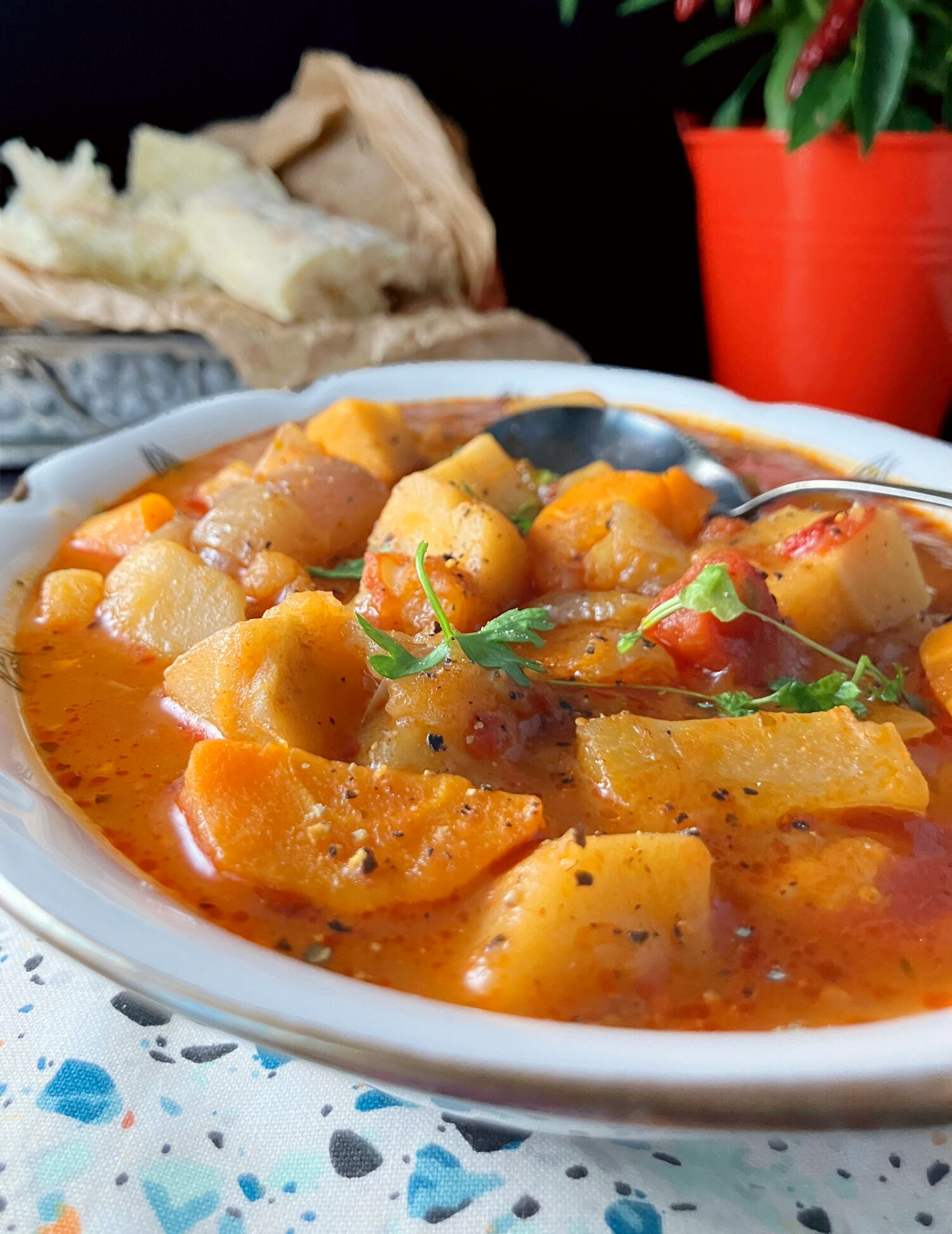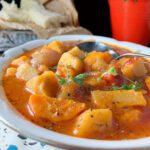Winter Vegetable Paprika Stew
This was so good! Definitely will make again!
★★★★★
This winter vegetable paprika stew is filling, economical, and tasty. The perfect hearty meal for a cold winter’s evening, it is made with carrots, swede, potatoes, onions and parsnip, but you can add anything you like.
Winter vegetable paprika stew: the perfect winter food
This winter vegetable paprika stew is just the thing as the cold, dark nights draw in.
I work full time and often feel little motivation to cook a healthy meal when I come home. But I also crave filling, warming food when the winter falls. Although this stew needs some preparation (mainly peeling vegetables) once that’s finished, it can be left to cook unattended. This means you can sit down with a nice glass of wine (or two) and chill while it cooks.
My paprika stew has onions, peppers, carrots, swede, parsnips and tinned tomatoes, to name just a few ingredients. Then there’s the herbs and spices like cinnamon and of course, paprika. The best thing about it?Nothing is off limits. If you have vegetables lurking in the back of your fridge, begging to be used up, throw them in. The beauty of this stew is its flexibility. Although it is called a winter paprika stew, you can adapt it to any season, your taste, and what’s on hand.
Preparation and cooking time
Although the stew isn’t a 30 minute meal, once the vegetables are prepared, it can bubble away nicely on the stove top. A quick stir every now and again is all the maintenance it will need.
You need to cook it until the vegetables are nice and cooked (anyone else like they super soft?), which should take a couple of hours.
Make the stew in a slow-cooker
If you have a slow-cooker, then you could easily adapt my recipe:
- Prepare the vegetables as per the ingredients list: chop the onions, carrots, swede, parsnip, and potatoes
- Add all ingredients to the slow cooker
- Stir well so the butter and oil coat the vegetables and the spices are evenly distributed
- Cook on low heat for 6–8 hours, or on high for 3–4 hours, until the vegetables are tender and the sauce has thickened.
- Check seasoning before serving, add more salt or pepper if needed.
- Serve with a sprinkling of fresh herbs
What’s a swede: and how is it different from rutabaga and turnip?
Swedes and rutabagas are the exact same thing. They are a hardy vegetable, with a rough skin and yellow flesh. The name swede (which comes from Swedish turnip) is used in most commonwealth countries. In North America, it is known as rutabaga.
Turnips are much smaller and softer with white flesh. Although part of the same family, turnips are quite different. However, despite this, many areas in the UK refer to a swede as a turnip.
Here in Sweden, they are called kålrot (directly translated as cabbage root), which is an umbrella term for both swedes/rutabagas and turnips.
The history of swede (rutabaga)
The discovery of swede/rutabaga goes back to 1620, when a Swiss botanist noticing them growing wild in Sweden. Although we know the swede arrived on British shores at the end of the 18th century, how it happened, we are not entirely sure. Some say that it was introduced from Germany, while others say its seeds were brought as a gift by a Swedish king.
It didn’t take long for swedes to land in the USA, with the earliest mention recorded early in the 19th century. Along with its introduction to the USA came a new name: rutabaga, which is taken from the Swedish word rotabagge.
Which other vegetables would work in this stew?
I’ve used parsnips, carrot, swede (rutabaga), onions, and potatoes in this version. A classic combination that gives the stew a lovely balance of sweetness, earthiness, and body. But really, you can use whatever vegetables you like.
Good alternatives or additions include:
- Yams or sweet potatoes: for a touch of natural sweetness and creaminess.
- Turnips or kohlrabi: for a subtle, slightly peppery bite.
- Brussels sprouts: add them towards the end of cooking for a little texture and green colour.
- Celery, leeks, or fennel: to add depth of flavour.
Squashes, pumpkins, beetroot or even a handful of green beans can all work beautifully. Just keep an eye on the stew when it is cooking, as harder vegetables like pumpkin, butternut squash, or beetroot might need a little extra cooking time, while softer vegetables like zucchini or bell peppers can be added later so they don’t get mushy.
Nothing is off limits. If you have vegetables lurking in the back of your fridge, begging to be used up, throw them in. The beauty of this stew is its flexibility. Although it is called a winter paprika stew, you can adapt it to any season, your taste, and what’s on hand.
Can I add meat to my winter stew?
Yes, of course!
I’ve been a pescatarian for four years, so this recipe is naturally vegetable-packed and filling on its own, especially with a good slice of bread. So, it really doesn’t need meat. But if you want to include some, there are several easy ways to do it:
Chicken:
- Shredded cooked chicken is perfect. Just stir it in five minutes before serving just to warm it through.
- Raw chicken breast or thighs can be added at the same time as the onions and gently cooked until fully done (usually 10–15 minutes, depending on size).
Beef or lamb:
- Cubed stew meat works beautifully. Brown it first in the butter and oil with the onions to develop flavour, then add the vegetables and liquids.
- Simmer gently for 1½–2 hours until the meat is tender.
Pork:
- Small chunks of pork shoulder or tenderloin can be treated like beef: fry first, then simmer with the vegetables.
Tips for preparation:
- Cut the meat into even-sized pieces so it cooks evenly.
- Browning the meat first adds extra depth and richness to the stew.
If using a slow cooker, brown the meat first in a pan before adding it. This helps develop flavour that a slow cooker alone can’t achieve.
What can I serve with this winter vegetable paprika stew?
Lashings and lashings of bread. Don’t forget the butter. The sauce is fairly thin and needs a good old wedge of bread to soak up all the goodness. Of course you could add some mashed potato, or even pasta, but the stew has all the vegetables it needs.
Some great bread suggestions are:
- Soft buns: perfect for mopping up every last drop of sauce. Try my giant spelt buns or easy dinner rolls.
- Focaccia: light, fluffy, and full of flavour.
- Cheese garlic bread: rich, indulgent, and utterly delicious with the stew.
- Quick breads: easy, fast, and perfect for a last-minute addition. Think soda bread and spicy jalapeño quick bread.
- Wholegrain breads: hearty and wholesome, perfect for soaking up the sauce. Try my Swedish tekakor or oat buns.
- Seeded breads: a little crunch and extra flavour to complement the stew. My Swedish rye bread is perfect.
- No-knead bread: keep things really simple with Swedish frallor.
Creamy chilli prawn and fish noodles (ready in 30 minutes)
Sweet potato, leek and garlic soup
Spinach and ricotta lasagna rolls
Spicy roasted vine tomato soup
Mushroom stroganoff (30 minute meal)
Red peppar chilli sin carne (veggie chilli)
Winter Vegetable Paprika Stew
Ingredients
- 30g (2 tbsp) butter
- 2 tbsp olive oil
- 2 red onions (chopped into large chunks)
- 2 onions (chopped into large chunks) - see note 1
- 1 small chilli pepper (finely chopped)
- 1 tsp minced garlic
- 250g (8¾ oz) carrots (chopped into thick slices)
- 250g (8¾ oz) swede (chopped into chunks)
- 150g (5¼ oz) parsnip (chopped into small chunks)
- 800g (28 oz) potatoes (cut into large chunks)
- 400g (14 oz) tinned (canned) chopped tomatoes
- ¼ tsp cinnamon
- 2 tbsp ground paprika
- 1 tsp oregano
- sea salt (to taste)
- ground black pepper (to taste)
- 1 tbsp wine (optional)
- 1 litre (4¼ cups) water (or stock)
- sprinkling of fresh herbs (optional)
Instructions
- Add the butter and oil to a large pan.
- Cook the onions and chilli pepper until soft.
- Add the garlic and cook for a minute or two.
- Add the cinnamon, paprika and oregano, sea salt and black pepper.
- Add the wine (if using) and cook until it evaporates (only a minute or two).
- Add the tomatoes and water / stock.
- Stir so that everything is well mixed and leave to cook for a couple of hours on a slow heat. The stew is ready when the sauce thickens and the vegetables are cooked through.
- Serve immediately with a sprinkling of fresh herbs and a good helping of bread. Enjoy!
Notes
- Onions refer to what North Americans would call yellow onions.
- The measurements for the vegetables are approximate, so use them as a rough guide (neither the ingredients nor the quantities need to be exact).
- The vegetables are cut into different sizes, depending on how quickly they cook. This means that they should all be cooked at pretty much the same time.
2 thoughts on “Winter Vegetable Paprika Stew”
Leave a Reply








This was so good! Definitely will make again!
Thank you, Vanessa! One of my favourites, too!